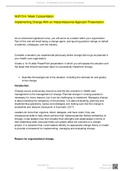Stuvia.com - The Marketplace to Buy and Sell your Study Material
NUR 514. Week 3 presentation
Implementing Change With an Interprofessional Approach Presentation
As an advanced registered nurse, you will serve as a leader within your organization.
Part of this role will entail being a change agent, and spurring positive change on behalf
of patients, colleagues, and the industry.
Consider a situation you experienced previously where change did not go as planned in
your health care organization.
Create a 10-15-slide PowerPoint presentation in which you will assess the situation and
the steps that should have been taken to successfully implement change.
1. Describe the background of the situation, including the rationale for and goal(s)
of the change.
Introduction.
Change occurs continuously around us and the key concerns in Health care
management is the management of change. Planned change in nursing practice is
necessary for many reasons, but it can be challenging to implement. Managing change
is about handling the complexity of the process. It is about evaluating, planning and
implementing operations, tactics and strategies and making sure that the change is
worthwhile and relevant (Gorbunoff, & Kummeth, 2017).
Leaders do more than organize, direct, delegate, and have vision; they use
interpersonal skills to help others achieve their highest potential. Before embarking on
change, nurse leaders may first consider their strengths and weaknesses in terms of
their leadership skills, because these can greatly affect the outcome of a change
project. It is important that nurse leaders identify an appropriate change theory or model
to provide a framework for implementing, managing and evaluating change.
Reason for organizational change.
Downloaded by: Want to earn
Distribution of this document is illegal $103 per month?
, Stuvia.com - The Marketplace to Buy and Sell your Study Material
Effective change has been characterized as unfreezing old behaviors, introducing new
ones, and re-freezing them. The strongest predictors that would ensure the change was
accepted would be assessing how ready the organization is for the pending change.
(Ruest, Leonard, Thomas, Desrosiers, & Guay, 2019). Change can be helpful or harmful
to an individual or an organization so by understanding organizational readiness, the
change will be positive (Ruest, Leonard, Thomas, Desrosiers, & Guay, 2019). One can
cause change, accept change, reject or fight change, or try to ignore change. The
outcome from all of these actions is likely to be different but properly managed change
can benefit the individual and the organization. Understanding and using a change
theory framework can help nurse leaders increase the likelihood of success. Nurse
Practitioners (NPs) can utilize their leadership capabilities to critically challenge health
care systems and act as a role model for others (Rawlings, 2018).
background of the situation
Hospice care is designed to provide comprehensive, interdisciplinary, team-based
palliative care, in the patient’s home, who have been identified with a short prognosis.
Hospice care is appropriate when patients and their families decide to forgo curative
therapies in order to focus on maximizing comfort and quality of life, when curative
treatments are no longer beneficial. By helping patients get the care they need,
palliative and hospice care can reduce health care spending for America's sickest and
most costly patient populations, by avoiding unnecessary emergency department and
hospital stays (Meier, 2011).
Studies have also shown that patients with a serious illness and their families receive
poor-quality medical care, characterized by untreated symptoms, unmet psychosocial
and personal care needs, low patient and family satisfaction and caregiver burnout.
Background – On call/ admission nurse for hospice care. The on-call nurse was to deal
with any calls that came into the organization after hours. This would include
patient/family calls, pending admissions and patient visits. Having worked with two
different hospice companies in two different cities, the companies were different, but the
problem was the same. One company was a start up hospice company in a large city
with over a hundred other hospice companies, and so the competition was fierce. The
other hospice company was well established with over 150 patients but was the only
hospice company on the mountain, with the nearest big city being three hours away.
The issue both companies had was the desire to grow but not have adequate staffing in
place, prior to the desired growth. The startup company ( Company A) wanted 10-20
patients in place before hiring another registered nurse and the established company
Downloaded by: Want to earn
Distribution of this document is illegal $103 per month?




